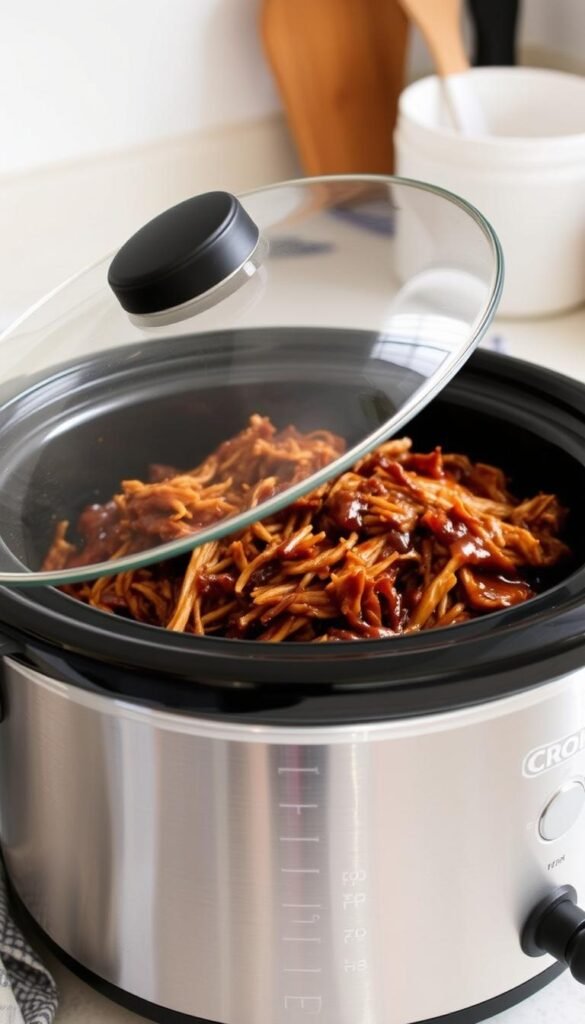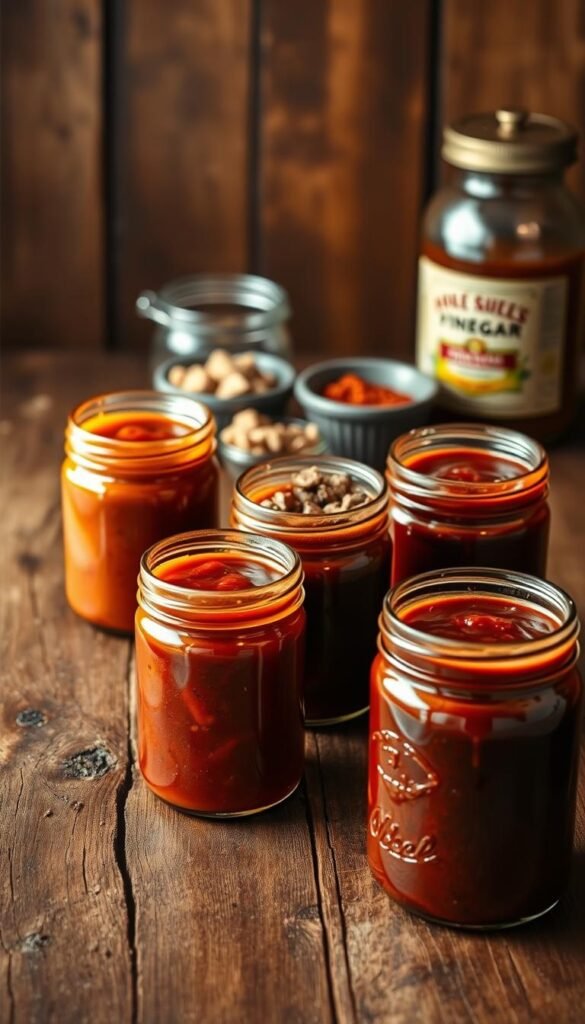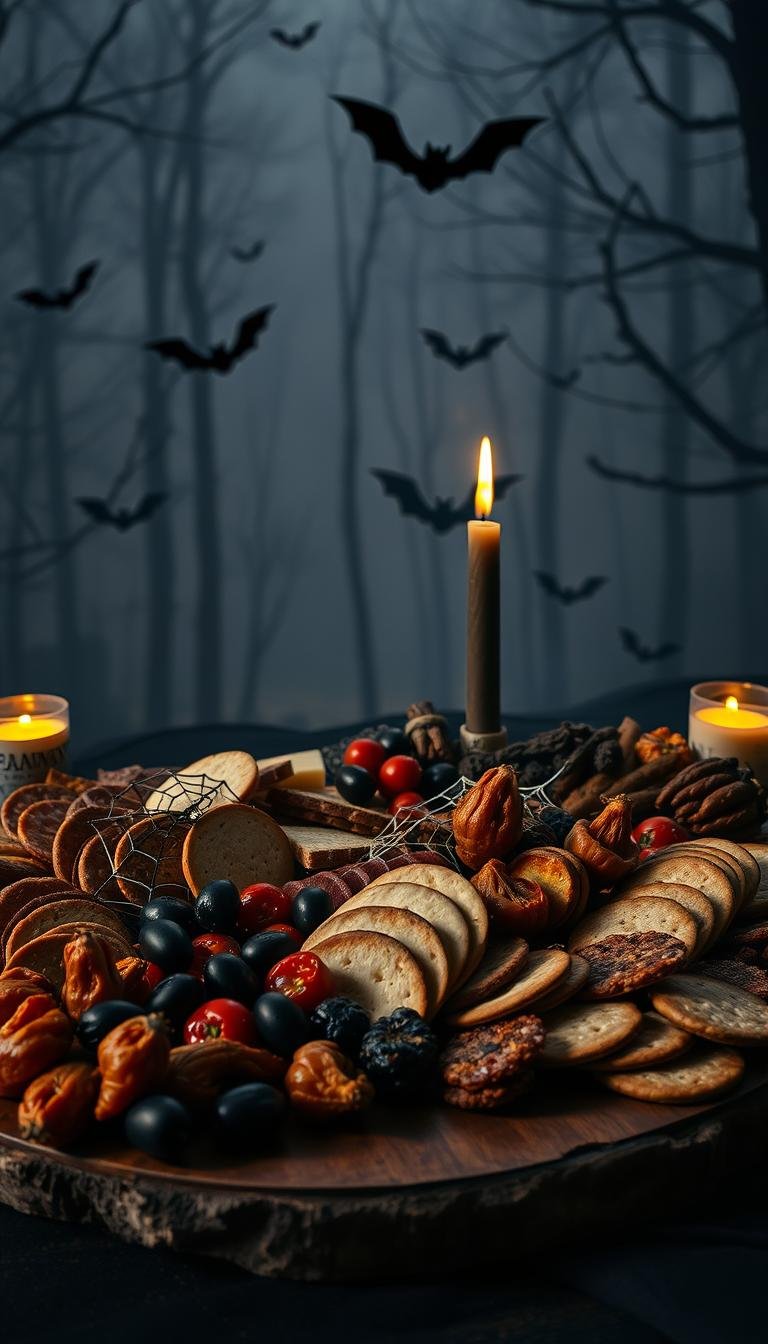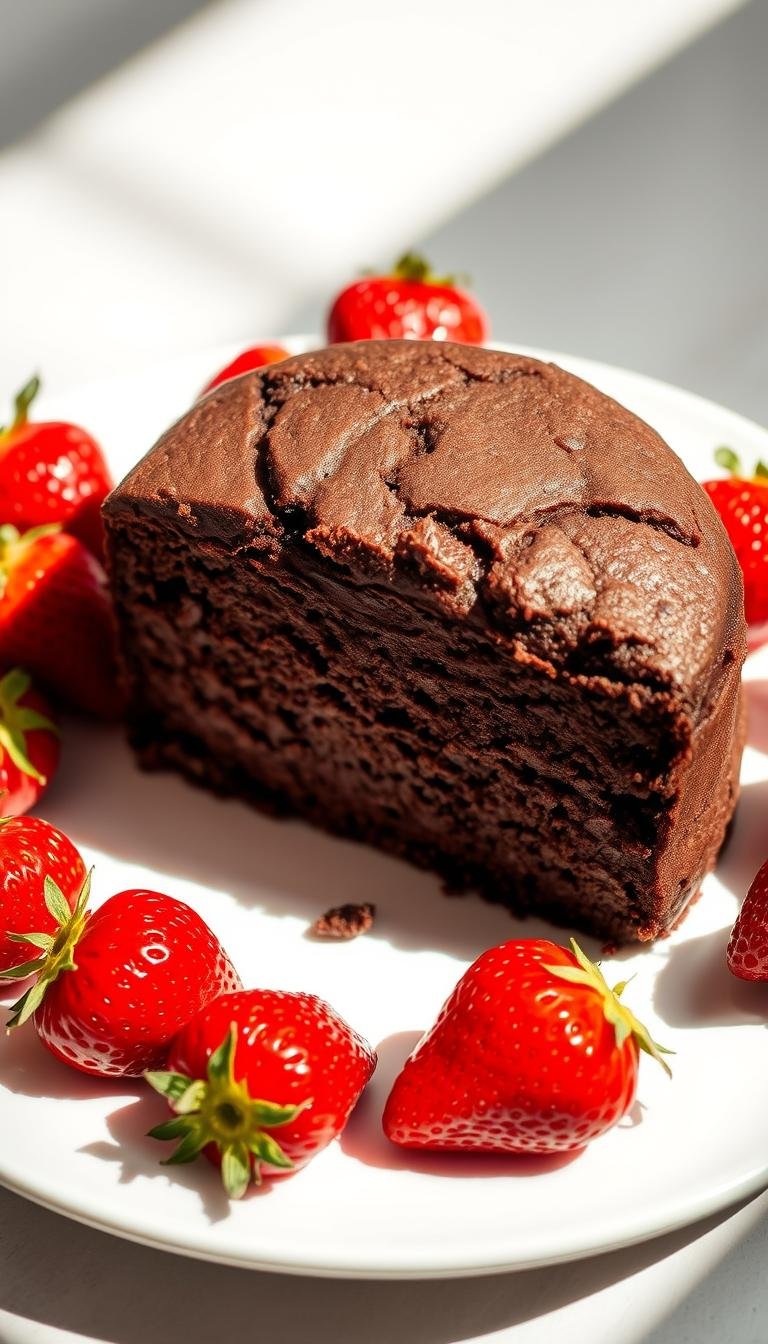Easy Crockpot BBQ Chicken Recipes for Any Occasion
Surprising fact: Nearly half of busy U.S. households rely on slow-cooker meals at least once a week to save time and still enjoy flavorful dinners.
This post gathers proven, hands-off methods so you get tender, juicy results every time.
Most tested slow cooker bases use about 3–4 pounds of boneless, skinless breasts and roughly 1½ cups of your favorite sauce. Simple add-ins like brown sugar, Worcestershire, or a splash of vinegar boost depth without extra fuss.
Cook on high for 2–4 hours or low for 5–7 hours until the meat hits about 165°F and shreds easily. Pros often drain excess liquid, then add fresh sauce to keep the flavor bright and the texture perfect.
We’ll show three styles: classic pulled, a quick 2-ingredient dump-and-go, and a pantry “doctored” version. Serve on buns with slaw and pickles, over baked potatoes, or in grain bowls for an easy family meal.
Key Takeaways
- Minimal prep and simple ingredients yield reliable, tender results.
- Safe cook windows: high 2–4 hrs, low 5–7 hrs; confirm 165°F internal temp.
- Drain cooking liquid and add fresh sauce for best texture and bold flavor.
- Three approach options let you pick speed or flavor depth.
- Versatile servings: sandwiches, baked potatoes, bowls, or salads.
Why You’ll Love Slow Cooker BBQ Chicken for Busy Nights
With minimal prep, your cooker will do the heavy lifting so you can focus on work, family time, or evening plans. This set-it-and-forget-it approach cuts active effort to a few minutes and frees up the rest of your day.
Set-it-and-forget-it convenience
Minimal hands-on prep means you often only mix a sauce, add the protein, and walk away. A standard 5–6 quart cooker feeds a family and makes leftovers that reheat well.
Tender, juicy results every time
Gentle cooking over hours yields pull-apart meat that shreds easily. Cook on high for 3–4 hours or low for 5–7 hours until the thickest part reaches 165°F for safe, reliable doneness.
- Low-and-slow improves juiciness; high shortens the wait.
- Kids like the sweet-savory flavor; adults enjoy balanced smoke and tang.
- Scale the recipe up or down for a couple or a crowd.
| Setting | Typical Hours | Result |
|---|---|---|
| High | 3–4 | Faster dinner, good tenderness |
| Low | 5–7 | Maximum juiciness, easy shredding |
| Finish | 10–15 minutes | Shred, add fresh sauce, hold warm |
crockpot bbq chicken recipes
Three simple approaches let you convert a few ingredients into a satisfying meal. Below are clear methods, cook windows, and quick finishing tips so you get consistent results every time.
Classic pulled barbecue chicken
What to do: Add 3 lbs boneless skinless chicken breast to the cooker with 1½ cups barbecue sauce, a diced onion, 1 tbsp Worcestershire, and 2 tbsp brown sugar.
Cook on high 2–3 hours or low 6–7 hours. Shred with two forks and return meat to the sauce for a glossy finish.
2-ingredient dump-and-go version
Place chicken and store sauce in the slow cooker. Cook on high 3–4 hours or low 5–6 hours until it pulls apart.
Tip: Drain the cooking liquid, then mix in fresh warmed sauce to concentrate flavor.
Doctored-up sauce with pantry staples
Whisk store sauce with 1–2 tbsp vinegar, 1 tbsp brown sugar, and ½ tsp garlic powder before adding to the cooker.
This simple tweak brightens and balances sweetness, great for sandwiches with slaw.
- Scaling: keep roughly 1½ cups sauce per 3 lbs meat for even cooking.
- Serving cues: classic for sliders, 2-ingredient for bowls, doctored for hearty sandwiches.
- Finish: shred or chop depending on texture you want; add extra warmed sauce to bind.
“Finish with warmed sauce so the meat stays glossy and clings to buns or grains.”
Ingredients You’ll Need for the Best BBQ Chicken
D. A short ingredient list and the right ratios are all you need for consistent, juicy results.
Primary protein: Use 3 lbs of boneless, skinless chicken breasts. This lean cut cooks evenly in the slow cooker and shreds cleanly into pulled meat with minimal fat.
Sauce and ratios
Measure about 1 1/2 cups of your favorite bbq sauce per 3 pounds of meat. This keeps coverage even and prevents a watery finish when you finish and recoat the shredded pieces.
Flavor boosters
Pantry add-ins lift a store bottle into a signature sauce. Try 2 tbsp brown sugar for sweetness, 1 tbsp Worcestershire or 1/4 cup vinegar for tang, and 1/2 grated onion or 1 tsp garlic powder for aroma.
Tip: Whisk vinegar, brown sugar, and garlic into store sauce to balance acidity and sugar before cooking. Taste the sauce and adjust so the final dish matches your family’s preference.
Optional fat and finishing notes
A tablespoon of olive oil adds gloss and mouthfeel without making the dish greasy. For heat, add a pinch of cayenne or a dash of chipotle.
- Brands: A honey-style bottle like Sweet Baby Ray’s is crowd-pleasing; use homemade sauce to control sugar and spice.
- Measure by cups when scaling; keep the sauce-to-meat ratio steady for best texture.
- Lean breasts deliver satisfying protein and help keep vitamin and nutrition goals in check.
Step-by-Step: How to Make Crockpot BBQ Chicken
Start with a smooth sauce blend and even coating so every piece cooks with the same taste. This short, clear routine keeps timing predictable and the final texture juicy.

Mix the sauce and coat the chicken
Whisk your sauce with optional boosters—brown sugar, vinegar, or garlic—until smooth. Stir in about 1½ cups per 3 lbs of chicken breast in a 5–6 qt cooker, then coat each piece so flavor spreads evenly.
Set cook time: high hours vs low hours
Choose high when minutes matter or low for gentler cooking. Plan typical windows: high 2–4 hours or low 5–7 hours. Check early; cooker model and breast size affect exact time.
Shred, sauce again, and keep it juicy
Remove the meat, shred with two forks, and taste for doneness (165°F). Drain excess liquid if watery, then return meat and stir in warm sauce so it glazes without pooling.
“Finish with warmed sauce so the meat stays glossy and clings to buns or grains.”
- Flip the cooker to warm to hold until serving.
- Taste and adjust—add vinegar for brightness or a pinch of heat.
- Use leftover minutes to prep slaw or potatoes.
Timing, Temperature, and Doneness Cues
Knowing the right cook windows helps you avoid dry meat and hit pull-apart texture.
High hours: plan roughly 2–4 hours on the high setting. This range works when you need dinner sooner, but check early if breasts are thin.
Low hours: aim for about 5–7 hours on low; some setups drift to 6–8 hours when the cooker is full or the breasts are thick.
Use a probe thermometer as your top tool. Verify the thickest chicken breast reaches at least 165°F to meet safety and keep the meat juicy.
Visual and texture cues
Properly cooked meat pulls apart easily with a fork and looks moist, not raw or overly glossy. If it resists, give it more time rather than extra sauce.
Practical tips
- Avoid frequent lid lifting—each peek adds time by releasing heat.
- If you shred and return meat to the cooker, the warm setting holds temperature safely during service.
- Record the exact hours your specific cooker needs; this builds reliable timing for future batches.
- Keep extra warmed bbq sauce on hand to refresh moisture if the mixture sits for a long time.
“Dried-out meat usually means the time window was overshot, not that you used too little sauce.”
Flavor Variations and Easy Ingredient Swaps
A few simple swaps can shift your flavor from sweet to smoky or add a clean heat. Start by choosing a sauce profile that suits your crowd and then tweak a couple of pantry items to make it yours.

Sweet, smoky, or spicy sauce options
Sweet and tangy works well for family dinners and sliders. Pick a honey-forward bottle for mild kids’ palates.
Smoky blends add depth—mix a smoky store sauce with a touch of liquid smoke or chipotle for richness.
Brown sugar substitutes and lower-sugar sauces
To lower sugar, choose a reduced-sugar bottle or a paleo-style sauce. A 1:1 brown sugar substitute blends directly into a doctored sauce with no fuss.
When to add heat: cayenne, hot sauce, or chipotle
Add spice to the sauce itself so heat cooks in. Try cayenne for quick burn, hot sauce for tang, or chipotle for smoky heat.
- Balance sweetness with apple cider or white vinegar.
- Boost umami with Worcestershire or a splash of soy/coconut aminos.
- Mix one smoky and one sweet sauce to hit a crowd-pleasing middle ground.
Tip: Boneless skinless meat soaks up sauce quickly; taste before you finish, since concentrated spice can intensify after draining and reheating.
Serving Ideas for Family-Friendly Meals
Build a simple dinner bar and let everyone assemble their favorite plate. This keeps meals fast and gives the family choice at the table.
BBQ chicken sandwiches: Pile pulled meat onto lightly toasted buns. Top with creamy cabbage slaw and dill pickle chips for crunch and acidity.
Bowl combos: Place steamed rice in a warmed bowl, add corn and black beans, then spoon saucy meat on top. Finish with a drizzle of extra sauce and a squeeze of lime.
Loaded potatoes: Split baked potatoes, fluff the flesh with butter, then mound with warm meat. Add shredded cheddar, chopped green onions, and more sauce for richness.
Salads & weeknight plates: Serve warm meat over leafy greens with ranch, avocado, tomatoes, corn, black beans, red onion, and crunchy chips. For a simple dinner, pair with mashed or roasted potatoes and a small side of slaw or green beans.
- Slice the meat for chunkier texture in potatoes; shred it finer for sandwiches.
- Keep extra warmed sauce at the table so guests can adjust richness.
- Plan about 1/2 to 3/4 cup cooked meat per sandwich or bowl depending on appetite.
- Lightly toast buns and pre-warm bowls or potatoes so the meal stays hot and juicy.
| Serving | Key Toppings | Portion Guide |
|---|---|---|
| Sandwich | Creamy slaw, dill pickles | 1/2–3/4 cup per bun |
| Bowl | Rice, corn, black beans, extra sauce | 1/2–3/4 cup over 1 cup rice |
| Loaded Potato | Cheddar, green onions, butter | 3/4 cup plus 1 large potato |
| Salad/Plate | Ranch, avocado, tomatoes, chips | 1/2 cup as warm topping |
“Assemble a DIY bar at dinner so each family member customizes their plate.”
From Pulled to Shredded: Texture Tips and Liquids
The way you break down cooked meat defines how it performs in sandwiches, bowls, and potatoes. Small choices after the cook finish control juiciness and flavor concentration.
Fork-shredding vs chopping
Fork-shredding yields long, uniform strands that soak up sauce and work well in pulled chicken sandwiches and bowls.
Chopping makes chunkier pieces that hold up in baked potatoes or hearty plates without turning soggy.
Drain, then add fresh sauce
Remove the meat to shred, then briefly drain the pot to avoid a watered-down finish. Many cooks pour off most juices and return shredded chicken with warmed sauce for bold, concentrated flavor.
Keep it saucy without diluting
Reserve a tablespoon or two of cooking juices to thin the sauce if you want a looser texture. Shred while the meat is hot so strands pull cleanly and absorb sauce better.
- Taste and tweak: add more tang, heat, or sweetness at this stage.
- Finish on warm for a few minutes to let flavors meld and the meat rehydrate.
- Aim for a glossy coat that clings—avoid pooling by adding sauce gradually.
“If breasts seem dry, fold in a spoonful of cooking juice before the final saucing.”
Food Safety, Frozen Chicken, and Crockpot Best Practices
Prevent risk by planning thawing and temperature checks before you start the cooker. Safe handling keeps meals tasty and avoids foodborne illness.
Thaw safely: Fully defrost frozen meat in the refrigerator overnight. When short on time, thaw under cool running water in sealed packaging. Do not add frozen pieces directly to the slow cooker; it keeps the pot too long in the danger zone.
Use a reliable thermometer: Insert the probe into the thickest part of the breast. Confirm an internal temp of at least 165°F before serving to meet safety and texture goals.
Practical tips to avoid dryness and safety pitfalls
- Typical time cues: breasts often finish near 3–4 hours on high or about 6 hours on low—always verify with a thermometer.
- Trim visible fat and pat skinless chicken dry for consistent heat transfer and cleaner texture.
- Use a 5–6 quart cooker to allow space for circulation without overcrowding.
- Avoid lifting the lid repeatedly; check once near the end of the time window.
- When holding longer, stir every few minutes and add a splash of warmed sauce to prevent drying.
“When in doubt, measure temperature rather than guessing by the clock alone.”
| Issue | Best Practice | Why it matters |
|---|---|---|
| Frozen meat | Thaw in fridge or cool water | Prevents slow warm-up that breeds bacteria |
| Doneness | Use probe thermometer (165°F) | Ensures safety and ideal texture |
| Holding | Stir, add sauce, limit minutes | Prevents dryness and keeps flavor |
| Cooker size | 5–6 quart unit | Even heating and space for circulation |
Storing, Reheating, and Freezing Leftovers
A quick plan for refrigeration and freezing saves time and makes future meals faster.
Refrigerate leftover barbecue chicken in airtight containers and chill within two hours. Store for 3–4 days to keep flavor and safety intact.
Freezing guidance
Portion into labeled freezer bags or containers for easy thawing. Remove excess air and freeze up to 2–3 months for best quality.
Reheating without drying out
Reheat gently in a covered skillet over low heat. Add a splash of water or a spoonful of bbq sauce so meat stays moist; stir often and warm for a few minutes.
Microwave in short bursts, stirring between intervals. If the mix looks dry, add extra sauce before serving.
- Freeze extra sauce separately to refresh texture after thawing.
- Portion 1/2 to 3/4 cup per meal for quick lunches with rice or corn.
- For large batches, warm covered in a low oven and add a splash of liquid to prevent toughness.
“Avoid high heat or boiling when reheating; gentle warmth preserves tenderness.”
These steps keep your slow cooker bbq results tasting fresh and make the next meal feel like new. Use leftovers for sandwiches, baked potatoes, or a fast chicken recipe that saves time on busy nights.
Conclusion
This simple playbook turns pantry staples and a short set of steps into reliable weeknight wins.
Choose your approach—classic pulled, the 2-ingredient dump-and-go, or a doctored sauce—and you’ll get tender results that hold up through leftovers.
Stick to the cook windows (high ~2–4 hours or low ~5–7 hours) and confirm 165°F for safe, shreddable meat. Drain excess liquid, then re-sauce to concentrate the barbecue flavor and glossy texture.
Rotate serving ideas: sandwiches with slaw, loaded potatoes, hearty bowls, or salads. Double a batch to stash in the fridge or freezer for fast weeknight meals.
Follow the steps, watch the temp, finish with fresh sauce, and this bbq chicken recipe becomes a dependable favorite.






